Tai CHI Chuan Martial Power
Autor Jwing Ming Yangen Limba Engleză Hardback – 2 aug 2022
- As more people participate in Tai Chi, understanding the martial art elements are in higher demand.
- The true power inside Tai Chi is reserved for those who know where to look and how to develop it.
- The most comprehensive examination of Tai Chi's internal power to date.
Preț: 232.47 lei
Nou
Puncte Express: 349
Preț estimativ în valută:
44.49€ • 46.18$ • 37.10£
44.49€ • 46.18$ • 37.10£
Carte disponibilă
Livrare economică 01-15 martie
Livrare express 18-22 februarie pentru 41.35 lei
Preluare comenzi: 021 569.72.76
Specificații
ISBN-13: 9781594397691
ISBN-10: 1594397694
Pagini: 294
Dimensiuni: 200 x 246 x 5 mm
Greutate: 0.71 kg
Ediția:3rd edition
Editura: YMAA Publication Center
ISBN-10: 1594397694
Pagini: 294
Dimensiuni: 200 x 246 x 5 mm
Greutate: 0.71 kg
Ediția:3rd edition
Editura: YMAA Publication Center
Notă biografică
Dr. Yang, Jwing-Ming started his Gongfu training at the age of 15 under the Shaolin White Crane Master Cheng, Gin Gsao. Dr. Yang became an expert in the White Crane style of Chinese martial arts. With the same master he also studied Qin Na, Tui Na and Dian Xue massages, and herbal treatment.
At the age of 16, Dr. Yang began the study of Taijiquan under Master Kao, Tao. Dr. Yang's tai chi can be traced back to the Yang family through Master Kao's teacher Yue, Huanzhi, an indoor disciple of Yang, Chengfu.
After learning from Master Kao, Dr. Yang continued his study and research of Taijiquan. Dr. Yang has mastered the Taiji barehand sequence, pushing hands, the two-man fighting sequence, Taiji sword, Taiji saber, and Taiji Qigong.
Dr. Yang has been involved in Chinese Gongfu since 1961. During this time, he has spent 13 years learning Shaolin White Crane, Shaolin Long Fist, and Taijiquan. Dr. Yang has more than thirty years of instructional experience.
At the age of 16, Dr. Yang began the study of Taijiquan under Master Kao, Tao. Dr. Yang's tai chi can be traced back to the Yang family through Master Kao's teacher Yue, Huanzhi, an indoor disciple of Yang, Chengfu.
After learning from Master Kao, Dr. Yang continued his study and research of Taijiquan. Dr. Yang has mastered the Taiji barehand sequence, pushing hands, the two-man fighting sequence, Taiji sword, Taiji saber, and Taiji Qigong.
Dr. Yang has been involved in Chinese Gongfu since 1961. During this time, he has spent 13 years learning Shaolin White Crane, Shaolin Long Fist, and Taijiquan. Dr. Yang has more than thirty years of instructional experience.
Cuprins
Foreword
Preface
Chapter 1. General Introduction
Introduction
1-2. General History of Taijiquan
1-3. History of Yang Style Taijiquan
1-4. What is Taijiquan?
1-5. What Does Taiji Training Include?
1-6. The Proper Approach and the Sequence of Learning Taiji
1-7. The Real Meaning of Taijiquan
Chapter 2. Qi and Taijiquan
2-1. Introduction
2-2. Qi
2-3. Qi and Taijiquan
2-4. Posture and Taijiquan
2-5. How to Practice the Taijiquan Sequence
Chapter 3. Jing Martial Power
3-1. Introduction
3-2. General Definition of Jing
3-3. General Theory of Taiji Jing
3-4. Accumulating Jing in the Postures
3-5. The Key Points of Taiji Jing
3-6. The Different Jing and Their Applications
3-7. Summary of Jing Training
Chapter 4. Conclusion
Acknowledgements
Appendix A: Taiji Poetry and Songs
Appendix B: Translation and Glossary of Chinese Terms
Index
About the Author
Preface
Chapter 1. General Introduction
Introduction
1-2. General History of Taijiquan
1-3. History of Yang Style Taijiquan
1-4. What is Taijiquan?
1-5. What Does Taiji Training Include?
1-6. The Proper Approach and the Sequence of Learning Taiji
1-7. The Real Meaning of Taijiquan
Chapter 2. Qi and Taijiquan
2-1. Introduction
2-2. Qi
2-3. Qi and Taijiquan
2-4. Posture and Taijiquan
2-5. How to Practice the Taijiquan Sequence
Chapter 3. Jing Martial Power
3-1. Introduction
3-2. General Definition of Jing
3-3. General Theory of Taiji Jing
3-4. Accumulating Jing in the Postures
3-5. The Key Points of Taiji Jing
3-6. The Different Jing and Their Applications
3-7. Summary of Jing Training
Chapter 4. Conclusion
Acknowledgements
Appendix A: Taiji Poetry and Songs
Appendix B: Translation and Glossary of Chinese Terms
Index
About the Author



















